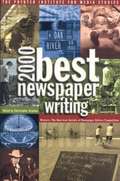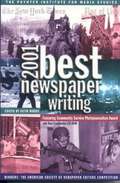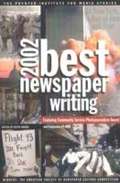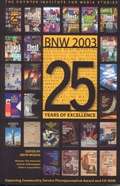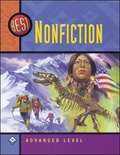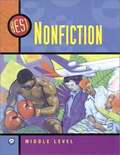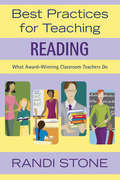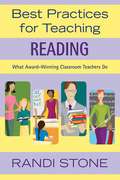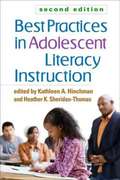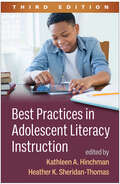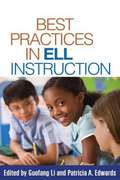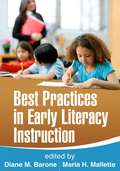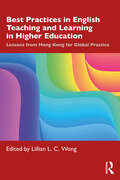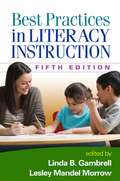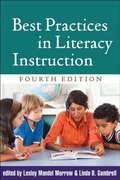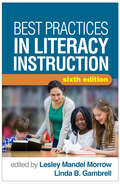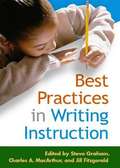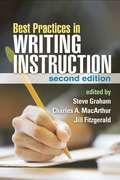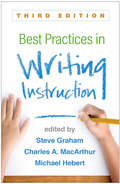- Table View
- List View
Best Newspaper Writing 1997
by Christopher Scanlan"Best Newspaper Writing 1997" celebrates the winners of the ASNE's Distinguished Writing Awards, including the Jesse Laventhol Awards, created to honor deadline reporting. It includes interviews with the winners about their craft; the work of 17 other writers who share the lessons they learned; study questions useful to students, teachers, and working journalists; a bibliography; and essays to help readers improve their writing.
Best Newspaper Writing 1998
by Christopher ScanlanBest Newspaper Writing for 1998 celebrates the winners of the American Society of Newspaper Editors Distinguished Writing Awards and highlights the best newspaper stories of 1998.
Best Newspaper Writing 1999
by Christopher ScanlanBest Newspaper Writing 1999 celebrates the winners of the ASNE's Distinguished Writing Awards, including the Jesse Laventhol Awards, created to honor deadline reporting. It includes interviews with the winners about their craft; the work of 17 other writers who share the lessons they learned; study questions useful to students, teachers, and working journalists; a bibliography; and essays to help readers improve their writing.
Best Newspaper Writing 2000
by Christopher ScanlanThis volume celebrates the winners of the ASNE's Distinguished Writing Awards, honoring deadline reporting, interviews with the winners and work of 13 other writers, sharing lessons they learned, with study questions useful to students, teachers, and journalists.
Best Newspaper Writing 2001
by Keith WoodsBest Newspaper Writing 2001 celebrates the winners of the American Society of Newspaper Editors Distinguished Writing Awards including the Jesse Laventhol Prizes, created to honor deadline reporting.
Best Newspaper Writing 2002
by Keith WoodsBest Newspaper Writing 2002 celebrates the winners of the ASNE Distinguished Writing Awards, including the Jesse Laventhol Prizes honoring deadline reporting. N.R. Kleinfeld of the New York Times reconstructed the morning of Sept. 11 with stories and stunning details. Jim Dwyer's short stories in the New York Times, resurrected from the smallest pieces of Sept. 11 debris, accomplish a feat that Dwyer himself describes in one of his poignant stories. The Wall Street Journal staff, amid a cloud of personal grief and national uncertainty, produced stories so stirring, encompassing, and complete that they remained relevant and vibrant long after Sept. 11. John McCormick, an editorial writer for the Chicago Tribune, displays amazing range -- from the contradictions of praying for peace amid war in Afghanistan, to a tribute to a murdered Chicago cop. Steve Lopez's storytelling always surprises, whether he's chronicling the unfolding tragedy of Sept. 11, or knocking back a six-pack of beer and a dozen doughnuts in the name of journalistic inquiry. Anne Hull of the Washington Post explores the gentrification of a neighborhood and the aftershocks of Sept. 11. Ellen Barry of the Boston Globe writes of the "Lost Boys" of Sudan, and their odyssey from African cattle herders to urban teens. J. Albert Diaz of the Miami, Herald captures the elusive concept of the American Dream.
Best Newspaper Writing 2003
by Keith WoodsBest Newspaper Writing 2003, the 25th anniversary of this prestigious series' publication, celebrates the winners of the ASNE Distinguished Writing Awards, including the Jesse Laventhol Prizes honoring deadline reporting.
Best Newspaper Writing 2005
by Aly ColónThe Poynter Institute once again brings you the year's best newswriting and community service photojournalism, showcasing the winners and finalists of the American Society of Newspaper Editors annual competition. The perfect reader for aspiring journalists, Best Newspaper Writing 2005 offers a wide array of exemplary writing and photojournalism, providing quality models students can analyze and emulate.
Best Nonfiction Advanced Level: 7 Selections for Young People with Lessons for Teaching the Basic Elements of Nonfiction
by Christine Lund Orciuch Theodore KnightThe Best Series is a fresh and innovative way to introduce and study genre-specific literature in your classroom. Students can explore and gain appreciation for exceptional and diverse writings in nonfiction. This enriching series strengthens students' reading and writing skills and literary techniques.
Best Nonfiction: 7 Selections for Young People with Lessons for Teaching the Basic Elements of Nonfiction
by Theodore Knight Christine Lind OrciuchThe Best Series is a fresh and innovative way to introduce and study genre-specific literature in your classroom. Students can explore and gain appreciation for exceptional and diverse writings in nonfiction.
Best Nonfiction: Introductory Level
by Christine Lund Orciuch Theodore KnightThe Best series collects superb nonfiction, play scripts, poetry, short stories, and stand-alone chapters of longer works, so you can quickly find well-crafted selections that reflect student interests. Best of all, we've tailored the series to three reading levels, making it the perfect tool for reaching out to students of any ability who aren't succeeding with more traditional anthologies.
Best Practices for Teaching Reading: What Award-Winning Classroom Teachers Do
by Randi B. StoneWith 40 classroom-tested strategies from award-winning teachers, this book offers guidance for teaching reading to elementary and secondary learners with diverse learning styles and abilities.
Best Practices for Teaching Reading: What Award-Winning Classroom Teachers Do
by Randi StoneFollowing the successful format of the companion volumes for teaching writing, mathematics, science, and social studies, Best Practices for Teaching Reading presents firsthand accounts of outstanding instructional strategies and lessons for teaching reading to students in both elementary and secondary school. Randi Stone brings readers into the classrooms of more than twenty-five award-winning teachers who share their unique and creative strategies for reaching elementary and secondary learners with diverse learning styles and abilities. From getting fourth-grade students excited to study Shakespeare to creating “wonder journals” to incorporating reading in the math classroom, these teachers have tried it all!With forty classroom-tested strategies, Best Practices for Teaching Reading provides practical guidance for building students’ decoding and vocabulary skills while developing their comprehension and motivation for reading. This collection of best practices presents useful tips in getting students to:· Get excited about reading· Make connections between different texts· Become effective writers as well as readers· Use literacy skills across the curriculumVeteran and new teachers alike will find an abundance of fresh ideas to teach reading while helping students build confidence, increase academic achievement, and develop critical thinking skills.
Best Practices in Adolescent Literacy Instruction, Second Edition
by Kathleen A. Hinchman Donna E. Alvermann Heather K. Sheridan-ThomasAn authoritative teacher resource and widely adopted text, this book provides a comprehensive overview of adolescent literacy instruction in the era of the Common Core State Standards (CCSS). Leading educators describe effective practices for motivating diverse learners in grades 5-12, building comprehension of multiple types of texts, integrating literacy and content-area instruction, and teaching English language learners and struggling readers. Case examples, lesson-planning ideas, and end-of-chapter discussion questions and activities enhance the utility of the volume. New to This Edition *Extensive CCSS content incorporated throughout the book. *Chapters on disciplinary literacy, text complexity, and differentiated instruction. *Chapters on academic language, writing instruction, history and English/language arts classrooms, and coaching.
Best Practices in Adolescent Literacy Instruction, Third Edition
by Kathleen A. Hinchman Donna E. Alvermann Heather K. Sheridan-ThomasWith 50% new material reflecting current research and pedagogical perspectives, this indispensable course text and teacher resource is now in a thoroughly revised third edition. Leading educators provide a comprehensive picture of reading, writing, and oral language instruction in grades 5–12. Chapters present effective practices for motivating adolescent learners, fostering comprehension of multiple types of texts, developing disciplinary literacies, engaging and celebrating students' sociocultural assets, and supporting English learners and struggling readers. Case examples, lesson-planning ideas, and end-of-chapter discussion questions and activities enhance the utility of the volume. New to This Edition *Chapters on new topics: building multicultural classrooms, Black girls&’ digital literacies, issues of equity and access, and creating inclusive writing communities. *New chapters on core topics: academic language, learning from multiple texts, and reading interventions. *Increased attention to issues of diversity, equity, and inclusion. *The latest knowledge about adolescents' in- and out-of-school literacies.
Best Practices in ELL Instruction
by Guofang Li Patricia EdwardsIn this indispensable work, prominent authorities review the latest research on all aspects of ELL instruction (K 12) and identify what works for today's students and schools. Provided are best-practice guidelines for targeting reading, writing, oral language, vocabulary, content-domain literacies, and other core skill areas; assessing culturally and linguistically diverse students; and building strong school home community partnerships. Chapters include clear-cut recommendations for teaching adolescent ELLs and those with learning disabilities. The comprehensive scope, explicit linkages from research to practice, and guidance for becoming a culturally informed, reflective practitioner make the book an ideal course text.
Best Practices in Early Literacy Instruction
by Marla H. Mallette Diane M. BaroneBringing together prominent scholars, this book shows how 21st-century research and theory can inform everyday instructional practices in early childhood classrooms (PreK-3). Coverage includes foundational topics such as alphabet learning, phonological awareness, oral language development, and learning to write, as well as cutting-edge topics such as digital literacy, informational texts, and response to intervention. Every chapter features guiding questions; an overview of ideas and findings on the topic at hand; specific suggestions for improving instruction, assessment, and/or the classroom environment; and an engrossing example of the practices in action.
Best Practices in English Teaching and Learning in Higher Education: Lessons from Hong Kong for Global Practice
by Wong, Lillian L. CLillian Wong brings together evidence- informed studies which are at the forefront of higher education developments in English language teaching and learning, and shares expertise from prominent academics in Hong Kong. Written by experienced practitioners who are active in the evolving field of scholarship of teaching and learning, it provides accessible and engaging insights into best practices in new and innovative areas, such as communities of practice, scholarship, big data analytics, digital literacies, blended learning, small private online courses, dialogic use of exemplars, students as tutors and critical thinking. The book covers best practices in three interrelated key areas in university English language education, including curriculum design and pedagogy, use of technologies and the teaching and learning of English in the disciplines. Linking theory and practice, the chapters discuss the emphasis on EAP/ ESP in university English language education, how technological developments are impacting the field and the implications for further research and the teaching of English in higher education. This resourceful collection is essential reading for teachers in- service and intraining, or those working in language education at the tertiary level where English is being used as an academic lingua franca, a medium of instruction or where EAP/ ESP plays an important role. Researchers in TESOL and applied linguistics, curriculum designers and leaders, teacher educators and policymakers as well as undergraduate and postgraduate students will also find it valuable.
Best Practices in Literacy Instruction
by Lesley Mandel Morrow Ernest Morrell Heather Kenyon CaseyThis authoritative text and PreK–12 teacher resource is now in a substantially revised seventh edition with 80% new material, foregrounding advances in inclusive, equitable instruction. Teachers are guided through every major component of reading, as well as assessment, motivation, teaching bilingual learners, strengthening connections with families and communities, and more. The book presents principles and strategies for teaching literature and nonfiction texts, organizing and differentiating instruction, supporting struggling readers, and promoting digital literacy. Pedagogical features include chapter-opening bulleted previews of key points; reviews of the research evidence; recommendations for best practices in action, with examples from exemplary classrooms; and end-of-chapter engagement activities.
Best Practices in Literacy Instruction, Fifth Edition
by Timothy Shanahan Lesley Mandel Morrow Linda B. GambrellThis indispensable classroom resource and course text has inspired thousands of teachers to help their students become better readers and writers. The fifth edition addresses evidence-based best practices in the light of emerging research and national policy, actively tying classroom-based research, innovation, and instruction to the Common Core State Standards (CCSS). Practical suggestions and case studies empower PreK-8 teachers to support the needs of all their students while meeting Common Core goals. Each chapter includes concrete examples, Engagement Activities, and resources for further learning. New to This Edition: *Connects best practices with the requirements of the CCSS. *Incorporates the latest research findings and instructional practices. *Chapters on comprehending informational text, dual language learners, and new literacies. *Expanded topics include motivation, close reading, and text complexity.
Best Practices in Literacy Instruction, Fourth Edition
by Linda Gambrell Lesley MorrowA highly regarded teacher resource and widely adopted text, this book is grounded in current knowledge about literacy teaching and learning in grades Perk 8. The field's leading authorities present accessible recommendations for best practices that can be tailored to fit specific classroom circumstances and student populations. Provided are strategies for helping all students succeed including struggling readers and English language learners and for teaching each of the major components of literacy. The book also addresses ways to organize instruction and innovative uses of technology. Chapters include concrete examples, Engagement Activities, and resources for further learning. New to This Edition Incorporates the latest research findings and instructional practices. Chapters on motivation, content-area teaching, new literacies, and family literacy. Addresses timely topics such as response to intervention, the new common core standards, English language learning, and policy issues.
Best Practices in Literacy Instruction, Sixth Edition
by Lesley Mandel Morrow Linda B. Gambrell Heather Kenyon CaseyMany tens of thousands of preservice and inservice teachers have relied on this highly regarded text from leading experts, now in a revised and updated sixth edition. The latest knowledge about literacy teaching and learning is distilled into flexible strategies for helping all PreK–12 learners succeed. The book addresses major components of literacy, the needs of specific populations, motivation, assessment, approaches to organizing instruction, and more. Each chapter features bulleted previews of key points; reviews of the research evidence; recommendations for best practices in action, including examples from exemplary classrooms; and engagement activities that help teachers apply the knowledge and strategies they have learned. New to This Edition *Incorporates the latest research findings and instructional practices. *Chapters on new topics: developmental word study and the physiological, emotional, and behavioral foundations of literacy learning. *Chapters offering fresh, expanded perspectives on writing and vocabulary. *Increased attention to timely issues: classroom learning communities, teaching English learners, and the use of digital tools and multimodal texts.
Best Practices in Writing Instruction
by Steve Graham Charles MacarthurHighly practical and accessible, this indispensable book provides clear-cut strategies for improving K-12 writing instruction. The contributors are leading authorities who demonstrate proven ways to teach different aspects of writing, with chapters on planning, revision, sentence construction, handwriting, spelling, and motivation. The use of the Internet in instruction is addressed, and exemplary approaches to teaching English-language learners and students with special needs are discussed. The book also offers best-practice guidelines for designing an effective writing program. Focusing on everyday applications of current scientific research, the book features many illustrative case examples and vignettes.
Best Practices in Writing Instruction, Second Edition
by Steve Graham Charles A. Macarthur Jill FitzgeraldAn indispensable teacher resource and course text, this book presents evidence-based practices for helping all K-12 students develop their skills as writers. Every chapter draws clear connections to the Common Core State Standards (CCSS). Leading authorities describe how to teach the skills and strategies that students need to plan, draft, evaluate, and revise multiple types of texts. Also addressed are ways for teachers to integrate technology into the writing program, use assessment to inform instruction, teach writing in the content areas, and tailor instruction for English language learners and struggling writers. Helpful case examples are featured throughout.New to This Edition*Revised and expanded to address the CCSS.*Incorporates the latest research and instructional procedures.*Chapters on teaching argumentative and informative writing.*Chapters on college and career readiness, writing to learn, writing about texts, and response to intervention.
Best Practices in Writing Instruction, Third Edition
by Steve Graham Charles A. MacArthur Michael HebertWell established as a definitive text--and now revised and updated with eight new chapters--this book translates cutting-edge research into effective guidelines for teaching writing in grades K–12. Illustrated with vivid classroom examples, the book identifies the components of a complete, high-quality writing program. Leading experts provide strategies for teaching narrative and argumentative writing; using digital tools; helping students improve specific skills, from handwriting and spelling to sentence construction; teaching evaluation and revision; connecting reading and writing instruction; teaching vulnerable populations; using assessment to inform instruction; and more. New to This Edition *Chapters on new topics: setting up the writing classroom and writing from informational source material. *New chapters on core topics: narrative writing, handwriting and spelling, planning, assessment, special-needs learners, and English learners. *Increased attention to reading–writing connections and using digital tools. *Incorporates the latest research and instructional procedures. See also Handbook of Writing Research, Second Edition, edited by Charles A. MacArthur, Steve Graham, and Jill Fitzgerald, which provides a comprehensive overview of writing research that informs good practice.


